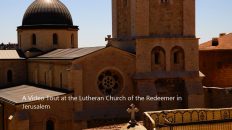“When he had thus spoken, he spat on the ground, and made clay of the spittle, and he anointed the eyes of the blind man with the clay. And said unto him, Go, wash in the Pool of Siloam, He went his way therefore, and washed, and came seeing.” (John 9:6-7)
The Pool of Siloam
Before we start our visit to the Pool of Siloam, let’s focus on the meaning of the name Siloam.
The Pool of Siloam in Jerusalem has a significant Christian archeological meaning. It is the Pool of Siloam in which, according to the Gospel of John, is the place where Jesus healed a blind man by putting a mud on his eyes and sending him to wash them with the water of the pool. The name Siloam is the Greek transliteration of the Hebrew name Shiloah, which means “send” or “let go.” Isn’t that interesting?
Now why is this site of the Pool of Siloam so unique?
Because if we can find archeological evidence of the location of the Pool of Siloam, we can be sure that Jesus has actually been at this site.
So where is the Pool of Siloam?
The Pool of Siloam is mentioned several times in the Bible. Isaiah 8:6 mentions the pool’s waters, while Isaiah 22:9 refers to the construction of Hezekiah’s Tunnel.
The Pool of Siloam is a rock-cut pool on the southern slope of the City of David, the original site of Jerusalem, located outside the walls of the Old City to the southeast. The pool is fed by the waters of the Gihon Spring.
Until 2004, people thought that the pool at the end of Hezekiah’s Tunnel was the right location. The Byzantine empress, Eudocia (400–460 A.D), was the first to build a church there, but was destroyed when Jerusalem was captures by the Muslims. Today we can see some of the church pillars located at that pool (now called the Byzantine Pool). For years, the Byzantine Pool of Siloam was a sacred destination for Christian pilgrims from all over the world.
In the autumn of 2004, during a sewer excavation in the area, stone steps were found. The shape of these steps and the fact that there was a corner to the steps led to the assumption that these were not regular steps but part of a Second Temple-period pool. Excavations commenced and confirmed that this is the original Pool of Siloam dating back to the time of Jesus.
This archeological finding made the Pool of Siloam one of few places in Jerusalem where we can be sure that today we can actually walk on stones that Jesus has actually walked on.
Hezekiah’s Tunnel
Now let’s talk about the Hezekiah’s Tunnel, which, as we mention above, leads the water from the Gihon Spring all the way to the Pool of Siloan. Hezekiah’s Tunnel is a tunnel that was dug underneath the City of David in Jerusalem in ancient times. Its popular name is due to the most common hypothesis of its origin, namely that it dates from the reign of Hezekiah of Judah (late 8th and early 7th century BCE) and corresponds to the waterworks mentioned in 2 Kings 20:20 in the Bible. According to the Bible, King Hezekiah prepared Jerusalem for an impending siege by the Assyrians by “blocking the source of the waters of the upper Gihon, and leading them straight down on the west to the City of David” (2 Chronicles 32). Support for the Hezekial dating is attributed both to the written inscription found on its wall (the Siloam Inscription, of which a replica can be seen in our video), and to radiocarbon dates of organic matter contained in the original plastering. However, the dates were challenged in 2011 by new excavations that suggested an origin in the late 9th or early 8th century BCE.
The tunnel, leading from the Gihon Spring to the Pool of Siloam, was designed as an aqueduct to provide Jerusalem with water during an impending siege by the Assyrians, led by Sennacherib. The curving tunnel is 533 m long, and by using a 30 cm (0.6‰) gradient altitude difference between each end, it conveyed water along its length from the spring to the pool.
According to the Siloam Inscription, the tunnel was excavated by two teams, one starting at each end of the tunnel and then meeting in the middle. The inscription is partly unreadable at present, and may originally have conveyed more information than this. It is clear from the tunnel itself that several directional errors were made during its construction.
The difficult feat of making two teams digging from opposite ends meet far underground is now understood to have been accomplished by directing the two teams from above using sounds generated by hammering on the solid karst through which the tunnelers were digging. Can you imagine that this was made 2700 years ago?
That is for today and until we meet in my next video let’s all live the Jerusalem Experience!






It is amazing that only in 2004 they have found the true pool of siloam. I was in jerusalem in 1998 and they took us to the byzantine pool of siloam. thank’s for making your video.
Thank you for taking us to many of the sites connected to the Bible. It is a wonderful experience.
My prayer is that I will be blessed to have the privilege of travelling to Israel to see the many places
Associated with our Lord and Saviour Jesus.
God bless you. Looking forward to seeing more videos of Jerusalem and Israel.